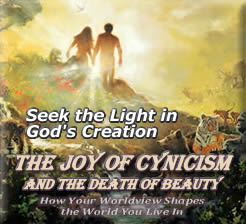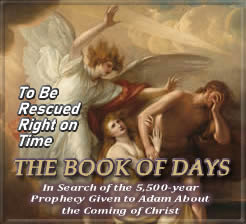A Hero for the Ages
The “Imageness” of God
In an age dominated by higher criticism and scientific snobbery, the veracity of The Bible is often called into question, usually by casting suspicion upon the historical narratives or the miraculous events contained in it. Consequently, cynicism and skepticism rule the day as the necessary price of intelligent inquiry, while faith and hope are set aside as the pathetic contrivances of wishful thinking. Throughout the pages of this work, however, we have sought to refute many of the reasons for such shortsighted conclusions. We have noted the limited frame of reference that humans have regarding the Divine, which constitutes a dimension of reality that is virtually impenetrable to creatures like us who are imprisoned by a fallen nature. Therefore, because of this limited perceptual condition, God has deigned to articulate His truth to mankind in terms of dramatic significance that transcends the foibles of human language. In addition, we have seen how, due to the symbolic nature of “storytelling,” the biblical message—in its conveyance of typological truth—is capable of both revealing and concealing knowledge.
So, when the scholar, fueled by higher criticism, demands a greater awareness of the historical process, which is said to dilute the integrity of textual information as it is transmitted from generation to generation, one need simply remind them that God is not nearly as frustrated as they are by such matters. He has already considered the problem and has preemptively designed the dramas of Scripture in such a way that they convey His truth regardless of such difficulties. More intriguing still is that one of the very objections offered by these same scholars is ironically a major proof of its divine authorship. According to critics, The Bible is said to have been corrupted as a result of being translated so many times. Yet the fact that the separate books still maintain such a clear-cut continuity from beginning to end is actually one of its most potent elements in demonstrating that mere mortals could not have been the only agency involved in its creation.
And when the scientist, gripped by intellectual snobbery, demands that The Bible be expunged of every trace of the miraculous, which is said to confound a realistic approach to the historical nature of the texts, once again, one need simply remind them that God has already figured out how to steer past that objection as well. Such scientific views appear all the more ironic when one considers that these same scientists, while denying the possibility of miracles when they are depicted in Scripture, still insist on believing in the miraculous when they pontificate about such things as the origins of matter or mankind. Never mind that no one was around to witness the Big Bang or has yet to observe the mutation of a gene. As long as one conveys such possibilities with the zeal of the medieval monk who was convinced that the Earth was the center of the Universe, then no one will ever dare to compare such leaps of faith with those that might be required in believing the so-called “poetic nonsense” of Genesis.
Story Continues Below
Says Richard Price—the founder and CEO of Academia.edu—on his podcast In Depth With Academia:
Tales of Forever: The Unfolding Drama of God’s Hidden Hand in History is:
To hear Price’s book review of Tales of Forever, CLICK HERE.
To hear Kent, Zen Garcia and S. Douglas Woodward, as they discuss the 5,500-year chronology from Adam to Christ, from the perspective of The Septuagint Bible, to confirm the contents of Tales of Forever, CLICK BELOW.
Story Continues From Above
All this is to underscore another aspect of our prior discussions: One of the reasons that God has apparently chosen to convey the biblical message via dramatic symbolism is because we are creatures with brains that are uniquely tuned to such modes of communication. In other words, it seems that, even in our fallen state of consciousness, our brains are hardwired to interpret data in a symbolic, metaphoric—dare I say—mythic dimension. So that regardless of the immeasurable gulf that exists between God and us there yet remains something in us that is tuned to the frequency of the Divine. That is to say, even though we live in a world where we are imprisoned by our five senses, we still possess some residual aspect of a God-like sensibility, simply by virtue of the fact that we have been created in the image of God.
The psalmist spoke of such incongruities when he wrote, “Deep calls unto deep.”1 Though his tears had been “food” for him day and night, he still remembered that God was there. He placed his hope in the Lord, though everyone around him bombarded him with the same nagging question: “Where is your God? Where is your God? Where is your God?”2 So how could he maintain a faith like that in the midst of so much misery and doubt? The answer was that the psalmist was able to stay connected to God, in spite of everything weighing in on him, because, as he put it, “deep calls unto deep, in the roar of Your waterfalls, all of Your waves have swept over me.”3 In other words, though everything and everyone sought to break his connection to God, there was something deep within his very being that mysteriously nullified the distance between his earthly existence and the Lord above. There was some ineffable quality—an “internal image,” if you will—that somehow maintained a direct link between his mortal being and that of the divine nature, which can be none other than the “imageness” of God, to make up a word.
What is more, this connection between God and mankind existed prior to the Advent of the Spirit as it was recorded in The Book of Acts, prior to the time that was predicted by John the Baptist, who declared that “soon there will be One Who is going to baptize the world with the Holy Spirit and fire.”4 This ineffable connection, then, is one that resides not just in the life of those individuals who claim to be Christians but is one that resides in all human beings. With this, I have finally come to the point I have been leading to in this chapter.








